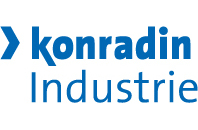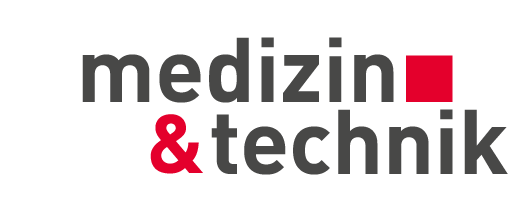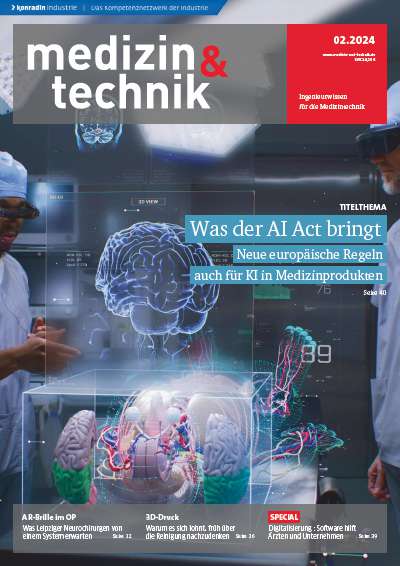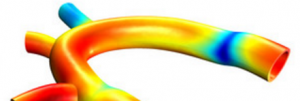It was pure hype for a long time, but Industry 4.0 is gradually gaining momentum in German factories. Companies in medical technology are not necessarily considered the trailblazers, however. Regulatory hurdles stand in the way. And for small and medium-sized enterprises, the smart factory does not pay off in most cases.
The smart, networked factory is coming. The German Association for Electrical, Electronic, & Information Technologies (VDE) in Frankfurt am Main is confident: Industry 4.0 will be reality in Germany within the next ten years at least. A survey of 1,300 member companies across all industries found that 34% of the companies are working specifically on Industry 4.0 at present. Yet, 70% of them are still in the observation and/or analysis phase. A third have already started individual operational projects. Large companies with 5,000 or more employees are responsible for the majority of these large projects, however. VDE did not provide exact figures on the use of Industry 4.0 in the medical technology industry in its study from the spring of this year. But the fact is that so far there have only been a few medical technology manufacturers to hop on the bandwagon. This should not come as a surprise considering VDE’s figures; large suppliers are few and far between in this industry.
Aesculap, a division of B. Braun Melsungen, is one of the few: with roughly 11,500 employees worldwide, Aesculap is one of the industry leaders in supplying products and services for core processes in surgery—and, with the Innovation Factory it opened at the end of 2014 at its headquarters in the Southwestern German town of Tuttlingen, it is an example of what networking and digitization can look like in production, and that moving in this direction is worth it. “Honestly, we did not think about Industry 4.0 for one second when we were planning and realizing the Innovation Factory,” confesses Dr. Joachim Schulz, member of the Aesculap management board, responsible for production and logistics. “We did talk about the topic, but it was under the auspices of digitization in production. In principle, this is what Industry 4.0 is about. What are important for us are the opportunities that Industry 4.0 can bring to our company, and not what is technically feasible.”
In the new factory, Aesculap manufactures sterile container and motor systems for surgical instruments based on Industry 4.0 principles—highly automated and interlinked workstations. The motor and container divisions are separate from one another at the factory—in a picture perfect world according to Industry 4.0 experts, this separation would definitely be taboo. As these experts see it, a tool should be able to find its own way though the interlinked factory, regardless of which product it is needed for. The example of Aesculap shows that the ideas of Industry 4.0 can be implemented in very different ways.
The fully automated production line for sterile containers has ten processing stations linked to seven robots and one fully automated sheet metal warehouse with about 600 storage areas. “Here we have interlinked many processes and work stations for a production line that were previously spread apart, and we replaced simple manual tasks with automated ones,” explains Schulz.
As soon as a sterile container (which is available in about 250 versions) leaves the logistics warehouse, a new production order for the exact same model is started. Schulz: “Our goal is to have fewer inventories as a way to reduce costs. Therefore, we have to restock the warehouse quickly all the time. Short throughput times are mandatory. And since we stopped using historical data to control production and started using outward stock movement, ultimately based on customer orders, we now have small batch sizes.” The result: sterile containers are manufactured within six minutes. This process once took three to four days, depending on version.
Aesculap follows the same goal of less capital commitment through reduced inventories in its motor system production line as well. The difference to sterile container manufacturing is that there are significantly more products here—namely more than 3,000 including all versions. “That is why we are less focused on interlinking and more focused on the smart, intelligent control of individual workstations with a high degree of manual activities—such as automated, need-based material handling,” explains Schulz. The throughput times have been drastically reduced in this area also—by 20 to 40%.
Aesculap is an example of one of the few cases from the medical technology industry where Industry 4.0 finds its way into practice. “The industry is characterized by small and medium-sized enterprises. And they have a difficult time identifying the potentials of the interlinked factory for themselves,” remarks Dr. Jens Nitsche, Director of Research & Development at consulting firm Ingenics, located in Ulm. “They do not know: what will it cost me? And how do I approach such projects?” Based on his experience, so far only a few medical technology suppliers have recognized that digitization can also help positively influence their business processes as well. A good example he gives are the manufacturers of prosthetic solutions in dentistry that use digital models to make and deliver individual products more or less on demand. Digitization opens up new business models and value added chains.
“The challenges associated with Industry 4.0 for the small and medium-sized enterprises in medical technology are enormous,” confirms Christian Neu, consultant at the SAP consulting firm DHC Dr. Herterich & Consultants, headquartered in Saarbrücken. “The IT systems for networking in production are very expensive and complex. The solutions are primarily designed for large companies. The rule of thumb: the more a company produces and the more diversified it is in production, the more Industry 4.0 will pay off.” The way Neu sees it, medical technology software needs to have solutions that can be scaled down, or “smaller, slimmed-down solutions” that are tailored to the production processes of medium-sized companies.
Aesculap board member Schulz agrees with the complexity of networked IT systems: “we have a variety of IT systems for networked manufacturing. You can never fully master this complexity. Sometimes trivial matters will turn into giant problems—like when a label printer in the warehouse stops functioning following an operating system update in the Microsoft world. When this happens, we cannot get the goods out of the door, even though the entire value added process worked perfectly before.”
Unlike Aesculap, many companies have outdated production systems; these old system make it harder to select the right solutions for networking and in production, as the authors from the German Federal Ministry for Economic Affairs and Energy concluded in their study “Industry 4.0—National and Industrial Economic Factors in Germany.”
“It is difficult especially for SMEs to keep up with the rapid technological developments and to continuously make the necessary investments,” says the study. Given this situation, “transitive technologies that allow old production technologies to be equipped for Industry 4.0 incrementally and economically would have an important role to play.”
“We do not want a sharp cut that will change everything—the technology should grow in and with our company’s culture,” iterates Holger Frank, CEO at Sanner GmbH based in Bensheim. With 500 employees, Sanner, supplier of plastic packaging for pharmaceutical and medical products, is a typical medium-sized, family-run company. He is taking a chance entering the Industry 4.0 era as a part of a project initiated by IHK Darmstadt. The objective is the prototypical implementation of a procedure model for introducing Industry 4.0 solutions. The model is designed to provide recommended actions for other small and medium-sized mass producers.
Several sub-projects are involved: for instance, the “IT and Processes” project group is working on interlinking the individual production systems more strongly with one another. The “Intralogistics” project group is also trying to figure out how to simplify and automate individual process steps: Sanner wants to remove cardboard boxes and wood pallets from production and make the movement of materials and goods more efficient. The groups are using simulation software to test the various concepts for efficiency, which will make their selection process easier. Building on the results of this project, Sanner is already thinking about other actions: something like a digital customer portal could someday coordinate all orders, ensure shorter delivery times, and speed up internal coordination processes. CEO Frank expects that it will take several years to introduce Industry 4.0 at Sanner.
The experts bring up regulations as another large hurdle to introducing Industry 4.0 production processes in medical technology. “The straitjacket around changes in the production process, especially with class III devices, is already so tight that we always have to consider very carefully whether we want to deviate from the processes that were already validated—which is what we would basically have to do in the case of Industry 4.0,” emphasizes Aesculap board member Schulz.
“Since the chain between the individual production steps and tasks is no longer clear in the pure Industry 4.0 culture, the classic quality gates do not exist in the same form anymore either. From a regulatory perspective, this is a problem,” explains Attorney at Law Phillip Reusch of Reusch Rechtsanwälte. “The new manufacturing processes correspond to the smallest degree with the legislative requirements that require there to be a central contact for the conformity of the overall result.” This poses problems during the product approval process. The product liability insurance systems are not designed for the new processes either. “They want to find a chain of causation which does not exist in Industry 4.0, or is at least hard to find.”
Yet Industry 4.0 would open up new opportunities in regard to traceability: smart products have integrated data chips that store information on the product’s properties and production steps. Reusch: “this technology would prevent companies from having to recall thousands of products in the event of a defect. The product in the Industry 4.0 era would ultimately be distinctly identifiable because the customer would have at hand all the individual manufacturing data from the first production step to delivery.”
Sabine Koll Journalist in Böblingen
CEO thinks that it will take several years to introduce Industry 4.0 in his company
Additional information about medical technology manufacturer Aesculap: www.aesculap.de (available in German only)about packaging manufacturer Sanner: www.sanner-group.com/en/ about IT consulting firm DHC Dr. Herterich & Consultants: www.dhc-gmbh.com/en/ about the Ingenics Industry 4.0 study: www.ingenics.com/en/news/current/ results-indstury40.php about Reusch Rechtsanwälte: www.reuschlaw.de/en/ about the Industry 4.0 competency center at VDE: www.vde.com/de/Technik/Industrie40 (in German) about the German Industry 4.0 platform: www.plattform-i40.de (available in German only) about the Industrial Internet Consortium in the USA: www.iiconsortium.org about the Swiss “Industry 2025” initiative: www.industrie2025.ch (available in German and French)
Opportunities and Obstacles
German companies see advantages and disadvantages in digitizing their production environment, as is shown in a representative survey conducted by the German IT industry association Bitkom, Berlin, in April 2015. The survey included 100 companies with at least 100 employees in each of the following sectors: automotive industry, engineering, chemicals industry, and electrical industry. Advantages include improved process quality, reduced production costs, and faster implementation times for individual customer requests. “Industry 4.0 creates growth and secures the continued existence of companies,” comments Winfried Holz, member of Bitkom’s executive committee. There are still many concerns, however: investment costs are an obstacle for 72% of the survey participants. The high complexity of the topic was listed as another obstacle by 56% of the participants, and just as many believe the lack of qualified workers is a problem.
In parallel to the Industry 4.0 platform in Germany, other countries around the world are making similar efforts to seize the opportunities of digital production. Examples:
- USA: the Industrial Internet Consortium (IIC) was founded in the USA in 2014 and is made up of 100 companies including GE, IBM, and Cisco.
- Switzerland: four Swiss industrial associations founded the national “Industry 2025” initiative in June 2015. The initiative is designed to pave the way for Industry 4.0 in this Alpine country.
- France: in April 2015 various associations, research institutes, and trade unions launched an association for the “Industry of the Future” (Assocation pour l’industrie du futur). They even introduced an action plan outlining three specific initial actions.
- Austria: The association “Industry 4.0 Austria—the Platform for Intelligent Production” started up in June. Involved parties include, among others, the Austrian Ministry for Transport, Innovation, and Technology.
Teilen:









